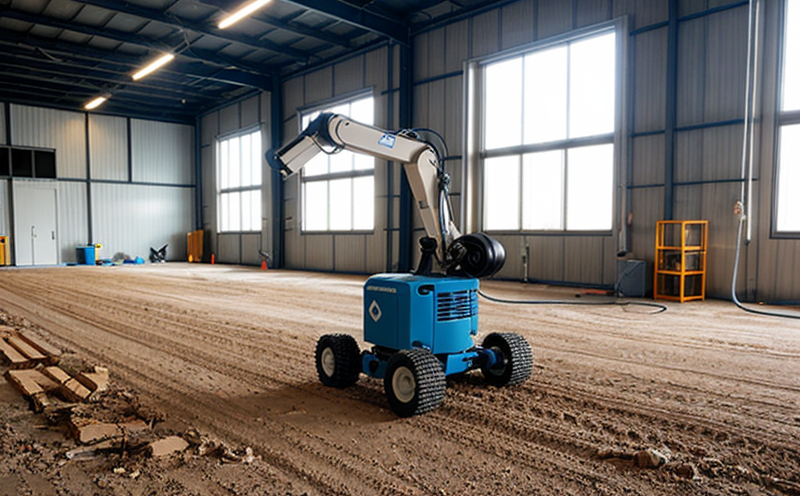EN 60068 Environmental Stress Testing of Industrial Robots
The International Standard IEC 60068-1:2019, commonly referred to as EN 60068, specifies the conditions under which electrical and electronic equipment, including industrial robots, should be tested for their resistance to environmental stresses. This standard is critical in ensuring that robotic systems can operate reliably under a wide range of environmental conditions encountered during their lifecycle.
The EN 60068 series includes multiple parts covering various types of environmental stress testing such as thermal shock, humidity, altitude, vibration, and more. For industrial robots, the most relevant part is IEC 60068-2-14, which addresses high-temperature storage tests.
The primary focus here is on ensuring that industrial robots maintain their performance under extreme conditions such as temperature fluctuations, humidity, and other environmental factors. The testing process involves exposing the robot to controlled environments where it must perform its intended functions without failure. This ensures that even in harsh or unpredictable environmental conditions, the robot remains functional and reliable.
Testing according to EN 60068 is essential for several reasons:
- To ensure compliance with international standards and regulations
- To protect against potential malfunctions due to environmental factors
- To improve product quality by identifying and rectifying design flaws early in the development process
- To enhance customer trust through proven reliability of robotic systems
The testing procedure typically includes preparing the robot for testing, subjecting it to specified environmental conditions, monitoring its performance during these conditions, and evaluating whether the equipment meets predefined criteria. This section will delve deeper into each step.
Before initiating any tests, the industrial robot must undergo thorough preparation to ensure accurate results. This involves:
- Cleaning the robot thoroughly
- Ensuring all sensors are calibrated correctly
- Verifying that all software updates and patches have been applied
- Performing initial operation checks to confirm baseline performance
The testing itself follows a structured approach. The robot is subjected to controlled environmental conditions, which may include:
- High temperature storage tests: Exposure to temperatures above the normal operating range of the robot.
- Vibration testing: Simulating the effects of mechanical stress on the robot during transport or operation in a dynamic environment.
- Humidity and dew point control: Ensuring that the robot can operate effectively even under high humidity conditions, which are common in many industrial settings.
During these tests, critical parameters such as motor performance, electrical connections, sensor accuracy, and overall stability of the robotic arm must be monitored closely. The test results are compared against predefined acceptance criteria to determine whether the robot meets the required standards for environmental robustness.
The testing process is designed not only to identify potential weaknesses but also to provide valuable insights into how industrial robots behave under extreme conditions. These insights can inform improvements in design and manufacturing processes, leading to more resilient and reliable robotic systems. Compliance with EN 60068 ensures that these systems are robust enough for use in various industries where environmental challenges are significant.
In summary, testing industrial robots according to EN 60068 is crucial for ensuring their reliability under diverse environmental conditions. By following this standard, manufacturers can enhance the durability and performance of their products, thereby increasing customer satisfaction and trust. This approach also helps in meeting regulatory requirements, which are essential for the safe and effective operation of robotic systems.
Industry Applications
- Automotive manufacturing: Ensuring robots can operate reliably in hot environments like assembly lines.
- Aerospace: Protecting robotic components from extreme temperatures during space missions or on-site inspections.
- Pharmaceuticals: Guaranteeing that automated systems are robust enough to handle the stringent temperature and humidity conditions found in clean rooms.
- Petrochemical industry: Providing industrial robots with the necessary resilience to operate safely in volatile environments.
The versatility of EN 60068 testing makes it an indispensable tool for various industries where environmental stressors are a significant concern. By adhering to these standards, manufacturers can ensure that their robotic systems perform consistently and reliably across diverse operational conditions.
Why Choose This Test
Selecting EN 60068 testing is advantageous for several reasons:
- Regulatory Compliance: Meeting international standards ensures compliance with local regulations, reducing the risk of legal issues.
- Risk Mitigation: Identifying and addressing potential failures early can prevent costly downtime and repairs in the field.
- Enhanced Reputation: Demonstrating robustness through rigorous testing enhances a company's reputation among customers and stakeholders.
- Improved Product Quality: The detailed nature of these tests helps manufacturers improve their products by pinpointing areas for enhancement.
The benefits extend beyond just the product itself. By ensuring that industrial robots meet stringent environmental standards, businesses can also improve operational efficiency, reduce maintenance costs, and ensure worker safety in hazardous environments.
Use Cases and Application Examples
EN 60068 testing is particularly beneficial for industries where environmental conditions are unpredictable or harsh. Here are some real-world use cases:
- Agriculture: Robots used in farming can be subjected to high humidity levels, requiring robust testing to ensure they perform effectively.
- Mining: Underground mining operations often face extreme temperatures and dust conditions; robots must withstand these harsh environments.
- Construction: Outdoor construction sites expose robots to varying weather conditions, necessitating thorough environmental stress tests.
In the automotive industry, robots used in painting booths are exposed to high humidity levels. Testing according to EN 60068 helps ensure that these robots can operate reliably even under such challenging conditions. In the pharmaceutical sector, compliance with these standards is crucial for robotic systems operating in sterile environments.
The aerospace and petrochemical industries also benefit from robust environmental testing. Robots used in space missions or handling volatile chemicals must be tested rigorously to ensure they perform consistently. By following EN 60068 guidelines, manufacturers can enhance their products' durability and reliability, leading to safer and more efficient operations.





